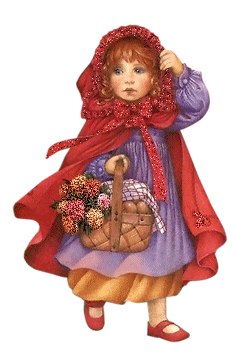YouTube "
Little Red Riding Hood" is a European
fairy tale about a young girl and a sly wolf. Its origins can be traced back to several pre-17th century European folk tales. The two best known versions were written by
Charles Perrault and the
Brothers Grimm.
The story has been changed considerably in various
retellings and subjected to numerous modern adaptations and readings. Other names for the story are: "
Little Red Cap" or simply "
Red Riding Hood". It is number 333 in the Aarne-Thompson classification system for folktales.
Tale The story revolves around a girl called Little Red Riding Hood. In
Perrault's versions of the tale, she is named after her
red hooded cape/cloak that she wears. The girl walks through the woods to deliver food to her sickly grandmother (wine and cake depending on the translation). In the Grimms' version, her mother had ordered her to stay strictly on the path.
A stalking wolf wants to eat the girl and the food in the basket. He asks her where she is going. She tells him. He suggests that she pick some flowers as a present for her grandmother, which she does. In the meantime, he goes to the grandmother's house and gains entry by pretending to be Riding Hood. He swallows the grandmother whole (in some stories, he locks her in the closet) and waits for the girl, disguised as the grandmother.
When the girl arrives, she notices that her grandmother looks very strange. She says, "What a deep voice you have!" ("The better to greet you with", responds the wolf), "Goodness, what big eyes you have!" ("The better to see you with", responds the wolf), "And what big hands you have!" ("The better to embrace you with", responds the wolf), and lastly, "What a big mouth you have" ("The better to eat you with!", responds the wolf), at which point the wolf jumps out of the bed and eats her, too. Then he falls asleep. In Charles Perrault's version of the story (the first version to be published), the tale ends here
In later and better-known versions, the story continues. A
woodcutter in the French version, or a hunter in the Brothers Grimm and traditional German versions, comes to the rescue with an axe, and cuts open the sleeping wolf. Little Red Riding Hood and her grandmother emerge shaken, but unharmed. Then they fill the wolf's body with heavy stones. The wolf awakens and attempts to flee, but the stones cause him to collapse and die. In the Grimms' version, the wolf leaves the house and tries to drink out of a well, but the stones in his stomach cause him to fall in and drown (similarly to the story of "
The Wolf and the Seven Little Kids").
Sanitized versions of the story have the grandmother locked in the closet instead of being eaten and some have Little Red Riding Hood saved by the lumberjack as the wolf advances on her rather than after she is eaten, where the woodcutter kills the wolf with his axe.
History Relationship to other tales The story displays many similarities to stories from classical Greece and Rome. Scholar Graham Anderson has compared the story to a local legend recounted by
Pausanias in which, each year, a virgin girl was offered to a
malevolent spirit dressed in the skin of a wolf, who raped the girl. Then, one year, the boxer Euthymos came along, slew the spirit, and married the girl who had been offered as a sacrifice. There are also a number of different stories recounted by Greek authors involving a woman named
Pyrrha (literally "fire") and a man with some name meaning "wolf". The Roman poet
Horace alludes to a tale in which a male child is rescued alive from the belly of
Lamia, an ogress in classical mythology.
The dialogue between the wolf and Little Red Riding Hood has analogies to the Norse
Þrymskviða from the Elder Edda; the giant
Þrymr had stolen
Mjölnir, Thor's hammer, and demanded
Feryja as his bride for its return. Instead, the gods dressed Thor as a bride and sent him. When the giants note Thor's unladylike eyes, eating, and drinking, Loki explains them as
Freyja's not having slept, eaten, or drunk, out of longing for the wedding. A parallel to another Norse myth, the chase and eventual murder of the sun goddess by the wolf
Sköll, has also been drawn.
A similar story also belongs to the North African tradition, namely in
Kabylia, where a number of versions are attested. The theme of the little girl who visits her (grand)dad in his cabin and is recognized by the sound of her bracelets constitutes the refrain of a well-known song by the modern singer
Idir "
A Vava Inouva": ‘I beseech you, open the door for me, father.
Jingle your bracelets, oh my daughter Ghriba.
I'm afraid of the monster in the forest, father.
I, too, am afraid, oh my daughter Ghriba.’





